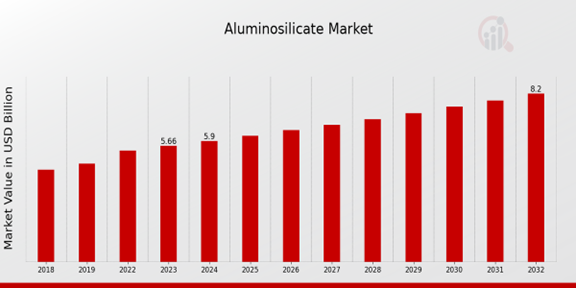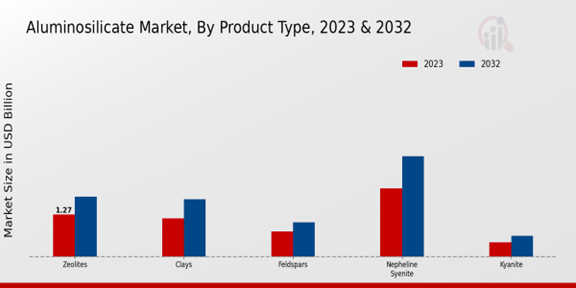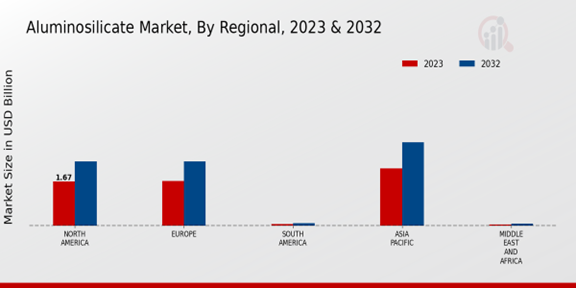Global Aluminosilicate Market Overview
The Aluminosilicate Market Size was estimated at 6.15(USD Billion) in 2024. The Aluminosilicate Industry is expected to grow from 6.4(USD Billion) in 2025 to 9.28(USD Billion) by 2034. The Aluminosilicate Market CAGR (growth rate) is expected to be around 4.20% during the forecast period (2025 - 2034).
In recent years, the saleability of the global aluminosilicates market has greatly improved, a trend that has been largely attributable to the escalating demand from the construction sector, automotive and paints coatings. Heavy weight is being replaced with light weight, and this has contributed the market. New directions for research and development are emerging in regard to a more sustainable and green aluminosilicate product range as residential, commercial, and other end-user industries demand and the regulations shift towards greener solutions. Increasing use of new or next-generation technologies, for example, nanotechnology has created new opportunities for innovation and new product development with improved properties and applications. Some other trends observed in the market include the introduction of functionalized aluminosilicates, which can be customized to specific needs. The development of specialized, and value added high performance materials, with improved durability, thermal stability, and chemical resistance are trending into the market.

Source: Primary Research, Secondary Research, MRFR Database and Analyst Review
Aluminosilicate Market Drivers
Growing Demand for Advanced Ceramics
Advanced ceramics are a type of materials applied in many industries, including aerospace, automotive, and electronics. Advanced ceramics are in demand due to their exceptional properties, such as high strength, heat and wear resistance, and perfect electrical insulation. Aluminosilicates are essential for the production of advanced ceramics. Consequently, the demand for advanced ceramics contributes to the expansion of the global market of aluminosilicates.In the automotive industry, the components of cars’ engines, brake and exhaust systems, and other parts that are utilized in high-temperature conditions are made of these materials. Similarly, the lightweight and high-temperature resources of ceramics make these materials appropriate for aerospace applications such as aircraft engines, heat shields, and radomes.
Expansion of the Construction Industry
The construction industry is a major consumer of aluminosilicates, which are used in the production of cement, concrete, and other building materials. The growing construction activities in emerging economies, particularly in the Asia-Pacific region, are fueling the demand for aluminosilicates. Aluminosilicates improve the strength, durability, and fire resistance of building materials, making them ideal for use in infrastructure projects, residential and commercial buildings, and industrial facilities.The increasing urbanization and population growth in developing countries are driving the expansion of the construction industry, which in turn is boosting the demand for aluminosilicates.
Technological Advancements and New Applications
Research and development initiatives that are being conducted continuously lead to the emergence of new applications for aluminosilicates in the sphere of industrial production. In particular, new technological applications for aluminosilicates are being developed in the sphere of energy storage systems such as lithium-ion batteries. It has been discovered that this material is able to significantly improve the performance and longevity of batteries.Moreover, the applications of aluminosilicates in the biomedicine industry, including drug delivery systems, and bone tissue engineering, are also emerging, considering their biocompatibility and release-control abilities. Overall, these newly emerged applications and advancement of technologies are expected to continue boosting the development of the Aluminosilicate Market Industry.
Aluminosilicate Market Segment Insights
Aluminosilicate Market Product Type Insights
The Aluminosilicate Market segmentation by product type includes zeolites, clays, feldspars, nepheline syenite, and kyanite. In 2023, the zeolites segment held the largest market share, accounting for over 35% of the global market revenue. This dominance is attributed to the extensive use of zeolites in various applications, including catalysis, adsorption, and ion exchange. The clays segment is projected to exhibit a significant growth rate during the forecast period, owing to the increasing demand for clays in the ceramics, construction, and paper industries.Feldspars are widely used in the glass and ceramics industries, and the segment is expected to grow steadily over the coming years. Nepheline syenite finds applications in the glass, ceramics, and paint industries, and the segment is anticipated to witness moderate growth. The market growth is driven by the increasing demand for aluminosilicates in various industries, including construction, automotive, and electronics. The rising population and urbanization are also contributing to market growth. The Aluminosilicate Market is highly competitive, with a number of key players operating in the market.Some of the prominent players include Imerys, Sibelco, and Quarzwerke. These companies are focusing on expanding their production capacities and geographical reach to cater to the growing demand for aluminosilicates. Overall, the Aluminosilicate Market is poised for continued growth in the coming years, driven by the increasing demand from various industries. The market is characterized by a high level of competition, with key players investing in capacity expansion and product innovation.

Source: Primary Research, Secondary Research, MRFR Database and Analyst Review
Aluminosilicate Market Application Insights
The application segment is a crucial aspect of the Aluminosilicate Market, shaping its growth trajectory and industry dynamics. Catalysts, adsorbents, fillers and extenders, construction, ceramics and glass are the key application segments, each offering unique market opportunities. Catalysts, with a projected valuation of USD 2.2 billion in 2024, are poised to dominate the market. Their use in various chemical processes, such as petroleum refining and petrochemicals, is driving segment growth. Adsorbents, estimated to reach USD 1.5 billion by 2024, are gaining traction due to their ability to remove impurities from liquids and gases.Fillers and extenders, with a market size of USD 1.2 billion in 2024, find application in paints, plastics, and rubber industries, enhancing product properties and reducing costs. Construction, valued at USD 1.1 billion in 2024, utilizes aluminosilicates in cement, concrete, and other building materials, contributing to their strength and durability. Ceramics and glass, with a market size of USD 1 billion in 2024, leverage aluminosilicates for their unique thermal and electrical properties, making them essential components in electronic devices, cookware, and other applications.These application segments are expected to witness steady growth in the coming years, driven by increasing demand from various industries and technological advancements. The Aluminosilicate Market segmentation provides valuable insights for industry participants to identify growth opportunities, target specific applications, and develop effective strategies for market penetration and expansion.
Aluminosilicate Market End-Use Industry Insights
The end-use industry segment plays a crucial role in shaping the dynamics of the Aluminosilicate Market. Chemical, automotive, pharmaceutical, paper and pulp, and construction are some of the key end-use industries that utilize aluminosilicates in various applications. In the chemical industry, aluminosilicates are employed as catalysts, adsorbents, and fillers in various processes. The automotive industry utilizes aluminosilicates in the production of catalytic converters and as lightweight fillers in composite materials. The pharmaceutical industry leverages aluminosilicates as excipients and drug delivery systems.In the paper and pulp industry, aluminosilicates are used as fillers and coating agents to enhance paper quality. This growth is attributed to the increasing demand from end-use industries, particularly in emerging economies. The chemical industry is expected to hold a significant share of the market due to the rising demand for aluminosilicates as catalysts and adsorbents. The automotive and construction industries are also anticipated to contribute to the market growth owing to the increasing production of vehicles and infrastructure projects.
Aluminosilicate Market Regional Insights
The Aluminosilicate Market is segmented into North America, Europe, APAC, South America, and MEA. Among these regions, North America is expected to hold the largest share of the market in 2023, owing to the presence of a large number of manufacturers and consumers of aluminosilicate in the region. Europe is expected to be the second-largest market for aluminosilicate, followed by APAC. The APAC region is expected to witness the highest growth rate in the coming years, due to the increasing demand for aluminosilicate from the construction and automotive industries in the region.South America and MEA are expected to account for a smaller share of the Aluminosilicate Market. The market growth in these regions is expected to be driven by the increasing demand for aluminosilicate from the construction and automotive industries.

Source: Primary Research, Secondary Research, MRFR Database and Analyst Review
Aluminosilicate Market Key Players And Competitive Insights
Major players in Aluminosilicate Market are continuously developing innovative products to meet the changing needs of the customers. Leading Aluminosilicate Market players are investing heavily in research and development to improve their product portfolio and stay ahead of the competition. The Aluminosilicate Market industry is highly competitive, with several major players vying for market share. The competitive landscape is expected to remain fragmented in the coming years, with new entrants expected to emerge and challenge the established players.Aluminosilicate Market industry is dominated by a few key players, including Albemarle Corporation, BASF SE, Clariant AG, PQ Corporation, and Solvay SA. These companies have a strong global presence and offer a wide range of aluminosilicate products. The market is also characterized by the presence of several regional and local players. The competitive landscape is expected to remain stable in the coming years, with the major players continuing to dominate the market.One of the leading companies in the Aluminosilicate Market is Albemarle Corporation. The company is a global leader in the production of specialty chemicals, including aluminosilicates. Albemarle's aluminosilicate products are used in a variety of applications, including catalysts, adsorbents, and fillers. The company has a strong global presence, with operations in over 100 countries. Albemarle is committed to innovation and sustainability, and it is constantly developing new products to meet the changing needs of its customers.A major competitor to Albemarle Corporation in the Aluminosilicate Market is BASF SE. BASF is a global chemical company that offers a wide range of products, including aluminosilicates. BASF's aluminosilicate products are used in a variety of applications, including catalysts, adsorbents, and fillers. The company has a strong global presence, with operations in over 180 countries. BASF is committed to innovation and sustainability, and it is constantly developing new products to meet the changing needs of its customers.
Key Companies in the Aluminosilicate Market Include
- M. Huber Corporation
- DELO Industrial Adhesives
- DuPont
- KaMin
- Zeochem
- Dow
- Belinka
- Imerys
- Sibelco
- Unimin Corporation
- Quarzwerke
- Wacker Chemie AG
- Luzenac Group
- LB Minerals
- Henkel
Aluminosilicate Market Industry Developments
The rising demand for lightweight and durable materials in automotive, construction, and aerospace industries is driving market growth. The increasing focus on energy-efficient construction and the growing adoption of composites in various applications are further fueling market expansion. Recent developments include the development of advanced aluminosilicate-based materials with enhanced thermal and mechanical properties. Moreover, the growing awareness of sustainable manufacturing practices is creating opportunities for the utilization of aluminosilicate in eco-friendly applications.
Aluminosilicate Market Segmentation Insights
- Aluminosilicate Market Product Type Outlook
- Zeolites
- Clays
- Feldspars
- Nepheline Syenite
- Kyanite
- Aluminosilicate Market Application Outlook
- Catalysts
- Adsorbents
- Fillers and Extenders
- Construction
- Ceramics and Glass
- Aluminosilicate Market End-Use Industry Outlook
- Chemical
- Automotive
- Pharmaceutical
- Paper and Pulp
- Construction
| Report Attribute/Metric |
Details |
| Market Size 2024 |
6.15(USD Billion) |
| Market Size 2025 |
6.4(USD Billion) |
| Market Size 2034 |
9.28(USD Billion) |
| Compound Annual Growth Rate (CAGR) |
4.20% (2025 - 2034) |
| Report Coverage |
Revenue Forecast, Competitive Landscape, Growth Factors, and Trends |
| Base Year |
2024 |
| Market Forecast Period |
2025 - 2034 |
| Historical Data |
2020 - 2024 |
| Market Forecast Units |
USD Billion |
| Key Companies Profiled |
J. M. Huber Corporation, DELO Industrial Adhesives, DuPont, KaMin, Zeochem, Dow, Belinka, Imerys, Sibelco, Unimin Corporation, Quarzwerke, Wacker Chemie AG, Luzenac Group, LB Minerals, Henkel |
| Segments Covered |
Product Type, Application, End-Use Industry, Regional |
| Key Market Opportunities |
Expanding automotive applications Rising demand for refractories Growing construction sector Increasing use in filtration systems Booming aerospace industry |
| Key Market Dynamics |
Growing construction industry increasing demand for lightweight materials technological advancements environmental regulations expanding automotive industry |
| Countries Covered |
North America, Europe, APAC, South America, MEA |
Frequently Asked Questions (FAQ) :
The Aluminosilicate Market is expected to reach USD 6.4 billion in 2025 and is projected to grow at a CAGR of 4.20% from 2025 to 2034, reaching USD 9.28 billion by 2034.
The Asia Pacific region is expected to hold the largest market share in the Aluminosilicate Market, followed by North America and Europe. The growth in the Asia Pacific region is attributed to the increasing demand for Aluminosilicate in various industries such as construction, automotive, and packaging.
Aluminosilicate is used in a wide range of applications, including construction materials, refractories, ceramics, and abrasives. In construction, Aluminosilicate is used as a lightweight aggregate in concrete and as a filler in cement. In refractories, Aluminosilicate is used to line furnaces and kilns. In ceramics, Aluminosilicate is used to make tiles, bricks, and pottery. In abrasives, Aluminosilicate is used to make grinding wheels and sandpaper.
The key competitors in the Aluminosilicate Market include Imerys, Sibelco, Arkema, and BASF. These companies have a strong global presence and offer a wide range of Aluminosilicate products.
The major factors driving the growth of the Aluminosilicate Market include the increasing demand for lightweight construction materials, the growing use of Aluminosilicate in refractories, and the rising demand for ceramics and abrasives.
The challenges faced by the Aluminosilicate Market include the volatility in raw material prices, the stringent environmental regulations, and the competition from alternative materials.
The opportunities for growth in the Aluminosilicate Market include the development of new applications for Aluminosilicate, the expansion into new markets, and the development of more sustainable production processes.
The Aluminosilicate Market is expected to grow at a CAGR of 4.20% from 2025 to 2034, reaching USD 9.28 billion by 2034.
The key trends in the Aluminosilicate Market include the increasing demand for lightweight construction materials, the growing use of Aluminosilicate in refractories, and the rising demand for ceramics and abrasives.
Aluminosilicate is used in a wide range of construction applications, including lightweight concrete, cement, and roofing materials. It is also used as a filler in asphalt and as a soil stabilizer.

















